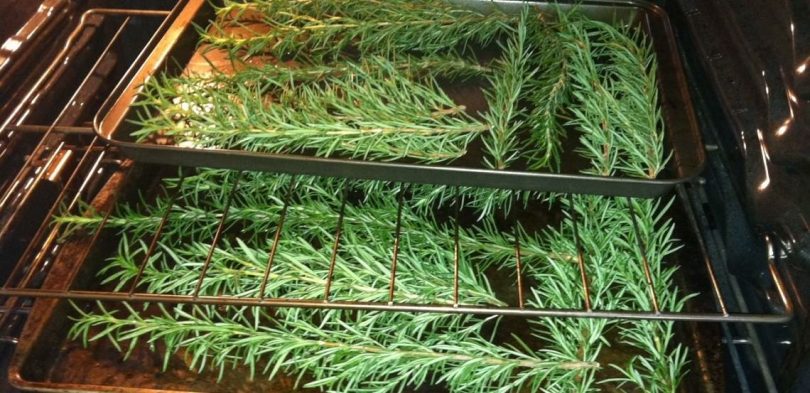Drying rosemary and storing it at home is the solution in preserving the plant’s flavor and aroma. The evergreen and drought-resistant rosemary can keep its texture, odor, and flavor in its dry, dehydrated condition.
There are several easy and convenient ways to preserve and dry rosemary at home: air drying, drying in the oven, dehydrating, and the use of a microwave oven.
READ ALSO: 6 Food Drying Methods – Pros, Cons and Best Tips
How to Dry Rosemary at Home
Before the drying
Items needed: Paper towels or a salad spinner
Before starting the drying process, the purchased or newly harvested rosemary plant should be rid of any thick, hard, woody stems, rinsed with clean water, and inspected for any tiny traces of dirt and pests. The fresh leaves and stems should be free from excess water by the use of either a salad spinner or paper towels.
Air-drying rosemary
Items needed: Strings or rubber bands, brown paper bags, kitchen or garden scissors, any dry area at home like the attic, porch or cupboard
- Separate the sprigs into individual groups (about eight sprigs each) and tie each bundle’s stem together with a string or a rubber band.
- The bundles should be hanged in a dry area of the house like the porch, cupboard or attic. When drying rosemary by air, it is best that the plant is covered with a paper bag punched with several holes to protect from sunlight, dust, and insects.
- Rosemary’s leaves and stems are expected to be stiff and dry after two weeks.
Drying rosemary in the oven
Items needed: Parchment or baking paper, gas stove or oven
- Pre-heat the oven to its lowest temperature. Set to warm or use the pilot light if a gas stove is used.
- Place fresh leaves and stems on a parchment or baking paper enough to fit over the oven’s or gas stove’s tray. You can pace the plants directly on a baking tray, but in that case, the temperature has to be as low as possible. Spread the plant parts distant enough to avoid overcrowding.
- Leave the oven door open about two inches. This will allow air to circulate and prevent the oven from getting too hot.
- Bake for two to four hours. Check from time to time until brittle.
Drying rosemary in the dehydrator
Items needed: Food dehydrator, food blender, parchment paper
- Place fresh leaves and stems on a parchment or baking paper enough to fit over the dehydrator’s tray. Spread the plant parts spaced evenly to avoid overcrowding.
- Turn the dehydrator on and adjust the temperature to 95 degrees Fahrenheit. Insert the plant parts on the tray and dry for four to six hours. Check from time to time until brittle.
READ ALSO: Which Food Dehydrator is Right for You
Drying rosemary in the microwave
Items needed: A plate suitable for microwave oven, microwave oven
- Set two pieces of paper towels over a plate that is a fit for microwave oven use.
- Place fresh leaves and stems on the plate. Spread the plant parts far enough to avoid overcrowding.
- Cover the herb with another piece of paper towel and insert the plate inside the device.
- Adjust the temperature to high heat and turn the microwave on for four minutes. If it hasn’t completely dried after heating, extend the drying time by two more minutes.
- Keep an eye on the microwave!!
Storing Dried Rosemary
The good news is that dry whole or crushed rosemary leaves and stems when properly stored will generally last from one to two years, can still be used beyond their observed disposal date, and will never spoil.
The bad news is that when improperly stored, the dried herb easily degrades when exposed to hot surroundings, damp places, and the sun. It will also lose its potency if stored longer than its expected shelf life.
The following are suggestions on how to keep dried rosemary ready for use anytime.
Items needed: Clean and dry dark-colored glass jars or tin cans
Check if the dried herb is totally dry.
For the air-dried process, whole or semi-whole parts should no longer bend and should crumble to the touch.
For the oven, dehydrator, and microwave drying methods, the leaves and stems should easily crumble and be crushed into a powdery appearance. A mortar and pestle or food blender can be used if a finer powder is desired.
Check remaining tough and blackened woody stems connected to the leaves. As you would expect, these burnt parts may result in a bitter taste when mixed with food.
Use dry, airtight containers to transfer and store the dried herb. Dark colored, screw-topped jars or tin cans are recommended. Jars with clamps can also be used but may be more expensive.
Store the herb away from sunlight and in a cool, dry place. Also, keep the jars away from sources of direct heat like ovens. Store them in cabinets, preferably located at the coolest part of the kitchen, such as the cellar or attic.
Label the bottles or jars to easily determine storage life during use. Print the name of the herb, the date bottled, and its expected date of disposal.
Drying rosemary at home is possibly the best way to preserve the herb’s astringent flavor and notable aroma. However, there are other ways of saving the plant’s culinary properties that do not involve drying. Freezing cut pieces of leaves and stems until solid then storing them in a Ziploc bag is an option. Making a mixture by combining fresh rosemary with olive oil or vinegar is an alternative. Another is creating a rosemary citrus salt blend by combining the leaves with rock sea salt and lemon then mixed in a food blender until the texture appears fine.
READ ALSO: A Complete Guide on How to Store Dried Herbs
All in all, whichever method you choose for drying rosemary and preserving rosemary’s flavor and aroma, be sure to follow the steps correctly and do think about proper storage.





